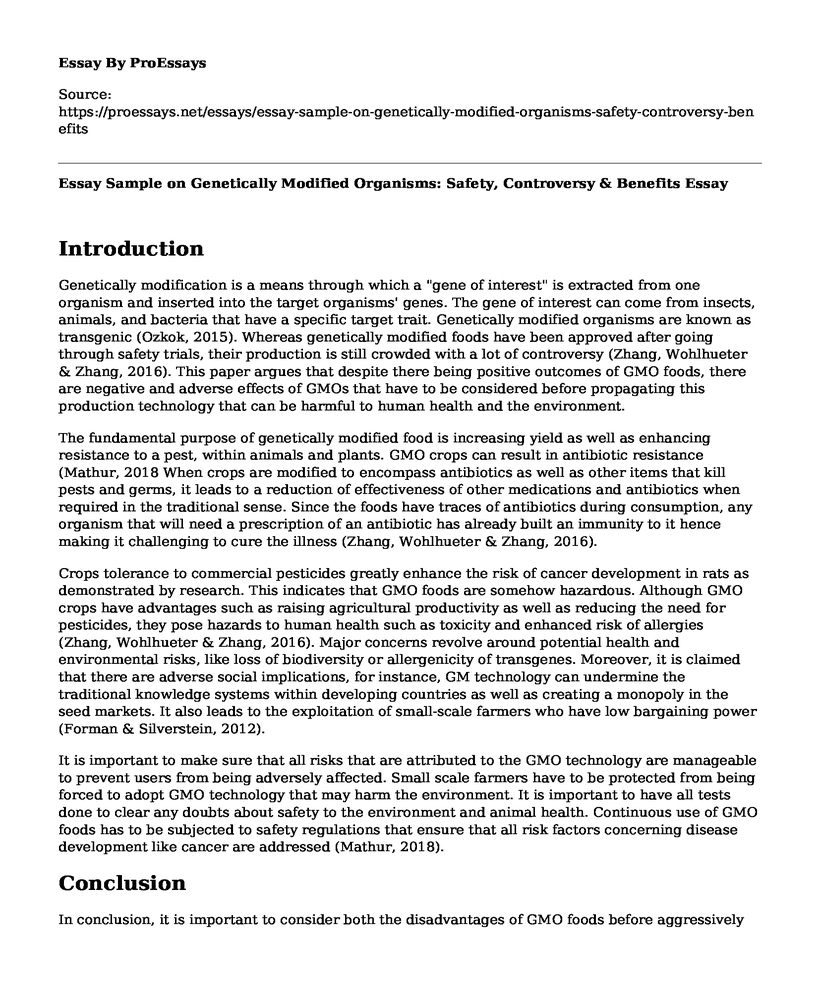Introduction
Genetically modification is a means through which a "gene of interest" is extracted from one organism and inserted into the target organisms' genes. The gene of interest can come from insects, animals, and bacteria that have a specific target trait. Genetically modified organisms are known as transgenic (Ozkok, 2015). Whereas genetically modified foods have been approved after going through safety trials, their production is still crowded with a lot of controversy (Zhang, Wohlhueter & Zhang, 2016). This paper argues that despite there being positive outcomes of GMO foods, there are negative and adverse effects of GMOs that have to be considered before propagating this production technology that can be harmful to human health and the environment.
The fundamental purpose of genetically modified food is increasing yield as well as enhancing resistance to a pest, within animals and plants. GMO crops can result in antibiotic resistance (Mathur, 2018 When crops are modified to encompass antibiotics as well as other items that kill pests and germs, it leads to a reduction of effectiveness of other medications and antibiotics when required in the traditional sense. Since the foods have traces of antibiotics during consumption, any organism that will need a prescription of an antibiotic has already built an immunity to it hence making it challenging to cure the illness (Zhang, Wohlhueter & Zhang, 2016).
Crops tolerance to commercial pesticides greatly enhance the risk of cancer development in rats as demonstrated by research. This indicates that GMO foods are somehow hazardous. Although GMO crops have advantages such as raising agricultural productivity as well as reducing the need for pesticides, they pose hazards to human health such as toxicity and enhanced risk of allergies (Zhang, Wohlhueter & Zhang, 2016). Major concerns revolve around potential health and environmental risks, like loss of biodiversity or allergenicity of transgenes. Moreover, it is claimed that there are adverse social implications, for instance, GM technology can undermine the traditional knowledge systems within developing countries as well as creating a monopoly in the seed markets. It also leads to the exploitation of small-scale farmers who have low bargaining power (Forman & Silverstein, 2012).
It is important to make sure that all risks that are attributed to the GMO technology are manageable to prevent users from being adversely affected. Small scale farmers have to be protected from being forced to adopt GMO technology that may harm the environment. It is important to have all tests done to clear any doubts about safety to the environment and animal health. Continuous use of GMO foods has to be subjected to safety regulations that ensure that all risk factors concerning disease development like cancer are addressed (Mathur, 2018).
Conclusion
In conclusion, it is important to consider both the disadvantages of GMO foods before aggressively marketing them to innocent users. Research has demonstrated injecting foods that have traces of antibiotics has led to human beings and animals developing resistance to antibiotics hence reducing their ability to treat and cure common diseases. The hazardous nature of carcinogens developed due to GMOs is responsible for the development of cancerous cells that most of the time cannot be cured. The mutations or DNA alteration that GMO employs in production is not perfectly safe. Scientists must continue to warm the public on the risks involved in the use of GMO foods.
References
Forman, J., & Silverstein, J. (2012). Organic foods: health and environmental advantages and disadvantages. Pediatrics, 130(5), e1406-e1415.
Mathur, R. (2018). Genetic engineering and biosafety in the use of genetically modified foods. International Journal of Advanced Scientific Research and Management, 76-82.
Ozkok, G. A. (2015). Genetically Modified Foods and the Probable Risks of Human Health. Int. J. Nutr. Food Sci, 4(3), 356-363.
Zhang, C., Wohlhueter, R., & Zhang, H. (2016). Genetically modified foods: A critical review of their promise and problems. Food Science and Human Wellness, 5(3), 116-123.
Cite this page
Essay Sample on Genetically Modified Organisms: Safety, Controversy & Benefits. (2023, May 22). Retrieved from https://proessays.net/essays/essay-sample-on-genetically-modified-organisms-safety-controversy-benefits
If you are the original author of this essay and no longer wish to have it published on the ProEssays website, please click below to request its removal:
- Personal Essay Example: My Views on Zoos
- Why Animals Should Be Excluded From Circuses Essay Example
- Plant Gene Breading and Human Gene Editing Paper Example
- Genetics in Treating and Developing Cancer Paper Example
- The Gluteus Maximus: A Powerful Muscle for Upright Posture - Essay Sample
- Essay on Grey Parrots: Psittacus Erithacus - Medium Sized, Black-Billed & Varied Colours
- Essay Example on the Next Decade: Human Augmentation & Global Challenges







